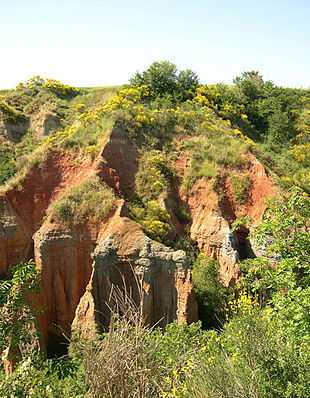Paleosol


In the geosciences, paleosol (palaeosol in Great Britain and Australia) can have two meanings. The first meaning, common in geology and paleontology, refers to a former soil preserved by burial underneath either sediments (alluvium or loess) or volcanic deposits (Volcanic ash), which in the case of older deposits have lithified into rock. In Quaternary geology, sedimentology, paleoclimatology, and geology in general, it is the typical and accepted practice to use the term "paleosol" to designate such "fossil" soils found buried within either sedimentary or volcanic deposits exposed in all continents as illustrated by Rettallack (2001), Kraus (1999), and innumerable other published papers and books.
In soil science, paleosols are soils formed long periods ago that have no relationship in their chemical and physical characteristics to the present-day climate or vegetation. Such soils form on extremely old continental cratons and as small scattered localities in outliers of ancient rock. Because of the changes in the Earth's climate over the last fifty million years, soils formed under tropical rainforest (or even savanna) have become exposed to increasingly arid climates which cause former Oxisols, Ultisols or even Alfisols to dry out in such a manner that a very hard crust is formed. This process has occurred so extensively in most parts of Australia as to restrict soil development - the former soil is effectively the parent material for a new soil, but it is so unweatherable that only a very poorly developed soil can exist in present dry climates, especially when they have become much drier during glacial periods in the Quaternary.
In other parts of Australia, and in many parts of Africa, drying out of former soils has not been so severe. This has led to large areas of relict podsols in quite dry climates in the far southern inland of Australia (where temperate rainforest was formerly dominant) and to the formation of Torrox soils in southern Africa. Here, present climates allow, effectively, the maintenance of the old soils under climates which they could not actually form if one were to start with the parent material on which they developed in the Mesozoic and Paleocene.
Paleosols in this sense are always exceedingly infertile soils, containing available phosphorus levels orders of magnitude lower than in temperate regions with younger soils. Ecological studies have shown that this has forced highly specialised evolution amongst Australian flora[1] to obtain minimal nutrient supplies. The fact that soil formation is simply not occurring makes ecologically sustainable management even more difficult. However, paleosols often contain the most exceptional biodiversity due to the absence of competition.[2]
See also
References
Retallack, G.J., 2001, Soils of the Past, 2nd ed. New York, Blackwell Science. ISBN 0-632-05376-3
Kraus, M.J., 1999, Paleosols in clastic sedimentary rocks: their geologic applications, Earth Science Review 47:41-70.